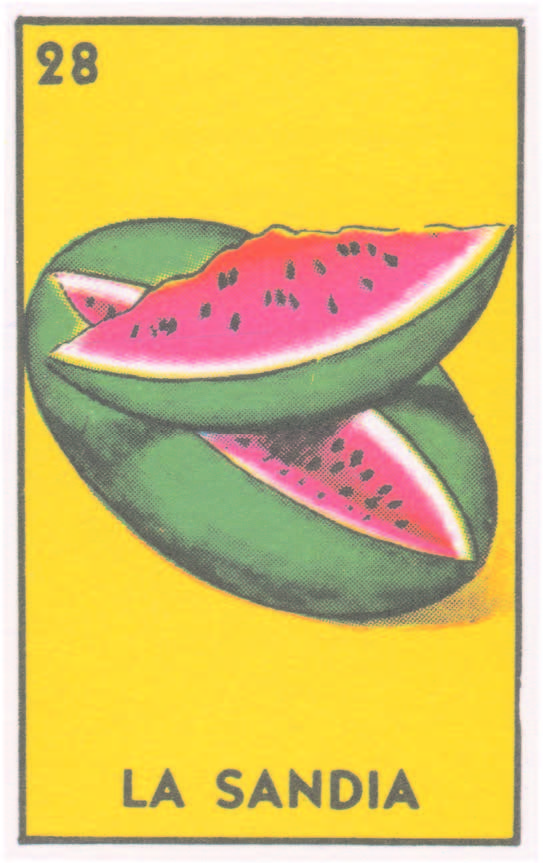Founded in 1887, La Lotería de Don Clemente is one of the most popular and traditional games of Mexico; it is enjoyed most commonly by children, gamblers, and revelers at village fairs known as ferías. It can be best described as Mexican bingo; on boxes of the game destined for the North American market, it is labeled as such. The only material difference between bingo and Lotería is that bingo relies on numbers, while Lotería uses images.
Three is the minimum recommended number of players for this game. One “sings” La Lotería while the others cover the appropriate images on their tablas, or playing boards.
Once the players have selected their tablas, the cards are shuffled and cut. The deck contains fifty-four cards with ordinary images such as an umbrella or a ladder, and archetypes such as the valiant one or the siren—a raven-haired, topless temptress riding the waves of the open sea. For ease of identification, the cards are also numbered. The object of the game is to make the designated line, or cover the entire tabla, as in “blackout.”
The game begins when the cantinero, or caller, draws the first card from the deck and then recites its corresponding dicho. The dichos are like riddles, and players race to cover the appropriate icon before their opponents. Here is an example:
The caller draws card number two, but instead of identifying the card by name, he reads the dicho: Pórtate bien cuatito, si no to lleva el coloradito. Players in the know immediately discern that this dicho applies to the little devil whose card warns: Behave yourself well little one, lest the little red one might make off with you.
Each game of Lotería comes with eighty fichas— small, yellow plastic discs to mark the tablas—but a Lotería purist will always use beans to mark his, preferably of the pinto variety, which are inexpensive, easy to prepare, and nutritious. A single serving supplies 25 percent of the recommended daily allowance of protein.
To play Lotería in its most traditional form, some Spanish is helpful, but by no means necessary. Most will be swept away by the beauty of the vibrant images. La Lotería can be asked for by name at your local supermercado and other lugares de costumbre. The tablas are such irresistible fodder for decoupage, they can be used to kitsch-up anything from a mirror to a light-switch plate. You will likely want one game for this, and another for its intended purpose.
Some will be attracted to La Lotería by its simple but poignant dichos. Number thirty, the shrimp, is of particular relevance. Its dicho states: Camarón que se duerme se lo lleva el corriente, “Shrimp who sleep will be carried away by the current.” In other words, if you snooze, you lose, and in this there is an important lesson. Rule number one when playing Lotería or bingo: You must shout your victory as soon as it occurs. If another card/number is drawn from the deck/hopper, before the winner declares ¡Lotería!/Bingo!, he can no longer claim his prize.
This happened to Aunt Teresa once at VFW Wednesday-night bingo, and it shamed our entire table. It was triple-bingo, the most nerve-racking and hard-to-follow game of them all, but still, there is no excuse. Aunt Teresa thought she was on for B-1, but it had been called many numbers before. It should be noted that being “on” is bingo-lingo for needing just one more number to win. By the time she realized her oversight, it was too late to do anything but feel bad about it. This ugly phenomenon is known as “sleeping it”—or in Spanish one might say,“se te durmió el gallo,” or “the rooster fell asleep on you.” Hence in bingo and/or Lotería, as in life, it’s best to keep one’s rooster’s eyes wide open.





